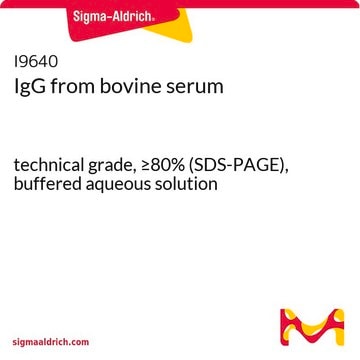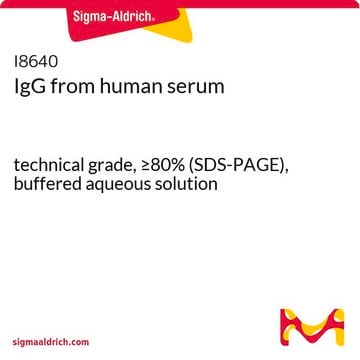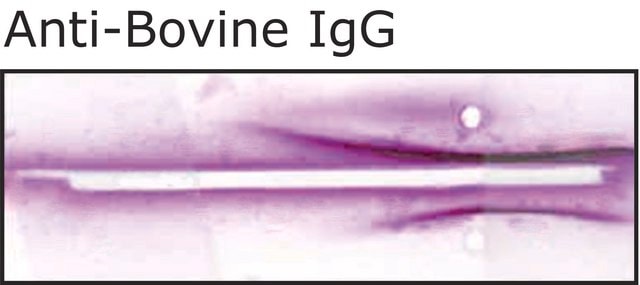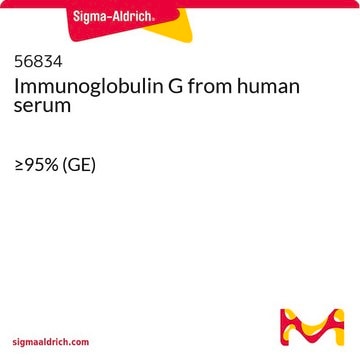I5506
IgG from bovine serum
reagent grade, ≥95% (SDS-PAGE), essentially salt-free, lyophilized powder
Synonym(s):
Bovine IgG
Sign Into View Organizational & Contract Pricing
All Photos(4)
About This Item
Recommended Products
conjugate
unconjugated
grade
reagent grade
Assay
≥95% (SDS-PAGE)
form
essentially salt-free, lyophilized powder
storage temp.
2-8°C
target post-translational modification
unmodified
Looking for similar products? Visit Product Comparison Guide
Related Categories
General description
IgG antibody subtype is the most abundant serum immunoglobulins of the immune system. It is secreted by B cells and is found in blood and extracellular fluids and provides protection from infections caused by bacteria, fungi and viruses. Maternal IgG is transferred to fetus through the placenta that is vital for immune defence of the neonate against infections
Bovine IgG is purified from pooled normal bovine serum by fractionation and ion-exchange chromatography.
Bovine IgG is purified from pooled normal bovine serum by fractionation and ion-exchange chromatography.
Application
Purified bovine IgG may be used as a reference antigen, standard, blocking agent, or coating protein in a variety of immunoassays including ELISA, dot immunobinding, Western immunoblotting, immunodiffusion, and immunoelectrophoresis. Other applications include starting materials for the preparation of immunogens and solid phase immunoadsorbents. Bovine IgG was used as control in electrophoresis and in liquid chromatography.
Disclaimer
Unless otherwise stated in our catalog or other company documentation accompanying the product(s), our products are intended for research use only and are not to be used for any other purpose, which includes but is not limited to, unauthorized commercial uses, in vitro diagnostic uses, ex vivo or in vivo therapeutic uses or any type of consumption or application to humans or animals.
Storage Class Code
11 - Combustible Solids
WGK
WGK 3
Flash Point(F)
Not applicable
Flash Point(C)
Not applicable
Certificates of Analysis (COA)
Search for Certificates of Analysis (COA) by entering the products Lot/Batch Number. Lot and Batch Numbers can be found on a product’s label following the words ‘Lot’ or ‘Batch’.
Already Own This Product?
Find documentation for the products that you have recently purchased in the Document Library.
Customers Also Viewed
Leyton W Gapper et al.
Analytical and bioanalytical chemistry, 389(1), 93-109 (2007-06-21)
The immunoprotective properties of bovine milk immunoglobulin G (IgG) have led to a recent proliferation of nutritional products incorporating this protein. It has therefore become critical that reliable analytical techniques for the measurement of the IgG content in such products
Diane Lee et al.
F1000Research, 8, 357-357 (2019-08-29)
The epithelial lining of the lung is often the first point of interaction between the host and inhaled pathogens, allergens and medications. Epithelial cells are therefore the main focus of studies which aim to shed light on host-pathogen interactions, to
Audrey L Shaw et al.
Clinical and experimental gastroenterology, 9, 365-375 (2016-12-17)
Previous studies have shown that oral administration of bovine immunoglobulin protein preparations is safe and provides nutritional and intestinal health benefits. The purpose of this study was to evaluate the plasma amino acid response following a single dose of serum-derived
Patrick T Holland et al.
Journal of agricultural and food chemistry, 59(10), 5248-5256 (2011-04-29)
Immunoglobulin-containing food products and nutraceuticals such as bovine colostrum are of interest to consumers as they may provide health benefits. Commercial scale colostrum products are valued for their immunoglobulin G (IgG) content and therefore require accurate analysis. One of the
Leyton Gapper
Journal of AOAC International, 96(5), 1026-1032 (2013-11-29)
Nine laboratories participated in an AOAC collaborative study to determine bovine immunoglobulin G (IgG) levels in selected dairy powders and dietary supplements by surface plasmon resonance (SPR) methodology. Each sample matrix was dissolved in buffer and suitably diluted to fit
Our team of scientists has experience in all areas of research including Life Science, Material Science, Chemical Synthesis, Chromatography, Analytical and many others.
Contact Technical Service











